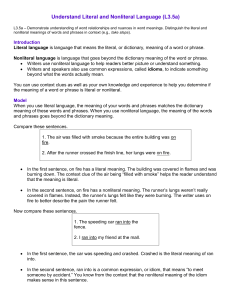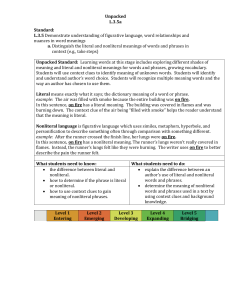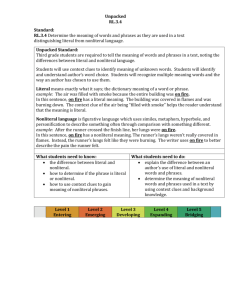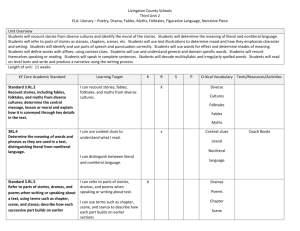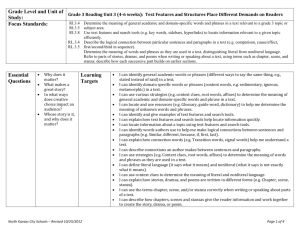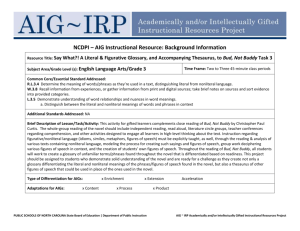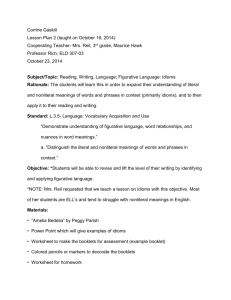Grade: 3 Title: Chocolate Fever Author: Robert Kimmel Smith Genre
advertisement
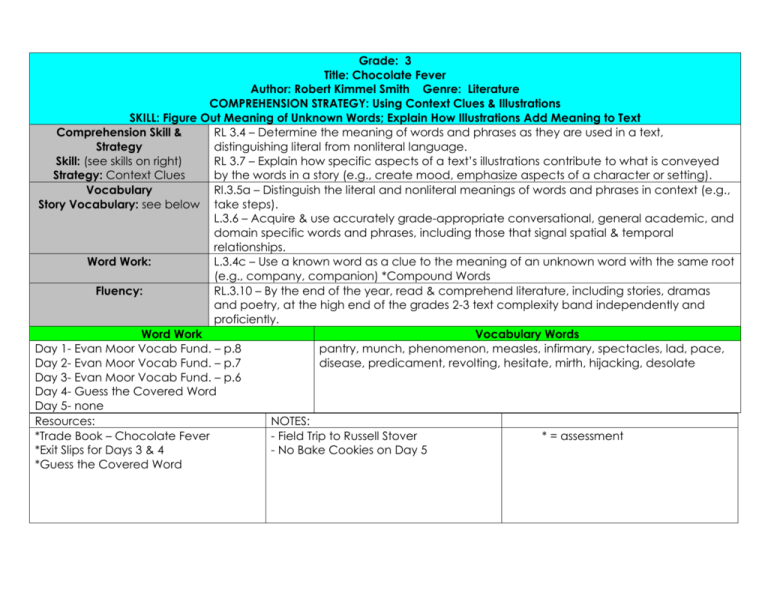
Grade: 3 Title: Chocolate Fever Author: Robert Kimmel Smith Genre: Literature COMPREHENSION STRATEGY: Using Context Clues & Illustrations SKILL: Figure Out Meaning of Unknown Words; Explain How Illustrations Add Meaning to Text Comprehension Skill & RL 3.4 – Determine the meaning of words and phrases as they are used in a text, Strategy distinguishing literal from nonliteral language. Skill: (see skills on right) RL 3.7 – Explain how specific aspects of a text’s illustrations contribute to what is conveyed Strategy: Context Clues by the words in a story (e.g., create mood, emphasize aspects of a character or setting). Vocabulary Rl.3.5a – Distinguish the literal and nonliteral meanings of words and phrases in context (e.g., Story Vocabulary: see below take steps). L.3.6 – Acquire & use accurately grade-appropriate conversational, general academic, and domain specific words and phrases, including those that signal spatial & temporal relationships. Word Work: L.3.4c – Use a known word as a clue to the meaning of an unknown word with the same root (e.g., company, companion) *Compound Words Fluency: RL.3.10 – By the end of the year, read & comprehend literature, including stories, dramas and poetry, at the high end of the grades 2-3 text complexity band independently and proficiently. Word Work Vocabulary Words Day 1- Evan Moor Vocab Fund. – p.8 pantry, munch, phenomenon, measles, infirmary, spectacles, lad, pace, Day 2- Evan Moor Vocab Fund. – p.7 disease, predicament, revolting, hesitate, mirth, hijacking, desolate Day 3- Evan Moor Vocab Fund. – p.6 Day 4- Guess the Covered Word Day 5- none Resources: NOTES: *Trade Book – Chocolate Fever - Field Trip to Russell Stover * = assessment *Exit Slips for Days 3 & 4 - No Bake Cookies on Day 5 *Guess the Covered Word Date: FOCUS 12:15 – 12:30 Working with Words Vocabulary 10 -15 minutes Direct Instruction 15 minutes Day 1 Day 2 Strategy: Context Clues to Figure Out Meaning of Unknown Words/Phrases – Decide Literal/Nonliteral Language Evan Moor Vocabulary Fundamentals, p. 8 (as whole class) pantry, munch, phenomenon, measles Strategy: Teacher Think Aloud w/ Illustration Introduce literal and nonliteral language Teacher Read & Think Aloud: Chapter 1 Using Context Clues ‘on the verge of a smile (p.15) Day 3 Day 4 Day 5 Strategy: Context Clues to Figure Out Meaning of Unknown Words/Phrases – Decide Literal/Nonliteral Language *Evan Moor Vocabulary Fundamentals, p.6 (independently) disease, predicament, revolting, hesitate Strategy: Context Clues to Figure Out Meaning of Unknown Words/Phrases – Decide Literal/Nonliteral Language Guess the Covered Word Strategy: Following Steps in Recipe mirth, hijacking, desolate *Matching Assessment Review literal/nonliteral language from yesterday. Review literal/nonliteral language; pictures/meaning. Review literal/nonliteral language. Focus on context clues. Introduce new skill: pictures/meaning Teacher Read Aloud: Chapter 6; model with ‘army of people’ (p.43) and illustration on pp. 4243 Teacher Read Aloud: Chapter 9; model with ‘Henry’s heart…’ (p.66) Using context clues – How could I figure out what a hijacking is? Or a stickup? How about a seizure? Model with ‘fracturing’ on p. 69.; Read Chapter 12; discuss the ending. Do you think Henry learned a lesson? (General discussion) (SL.3.1d – Explain their own ideas and understanding in light of discussion.) Evan Moor Vocabulary Fundamentals, p. 7 (with partners) infirmary, spectacles, lad, pace Teacher read aloud: Chapter 4; model with picture on p. 32 Time used for culminating activity (No Bake Cookies) Read recipe aloud ‘glumly’ on p. 71. Guided Practice 15 minutes Begin to Read Chapter 2 Think-Pair-Share on the phrase ‘carry on and behave like a nut’ (p.21) and ‘bite my head off’ (p.21) Teacher Read Aloud Chapter 5 while students follow along. Think Pair Share: ‘yelling their heads off’ (p. 34); ‘cool as a cantaloupe’ (p.34) Teacher Read Aloud through p. 45; students follow along. Think Pair Share: Is ‘scared to death’ literal or nonliteral? Look at title of Time used to make Chapter 10 – what do No Bake Cookies you think that means? Literally it would mean…, but nonliterally it could mean… Teacher finishes reading aloud Chapter 6; did you hear any examples of nonliteral language? (‘lump in throat’ p. 45) Independent Finish Chapter 2 and Chapter 3 Application 20 – 25 minutes Accountable Talk: What does the phrase ‘felt as if his heart were about to drop into his shoes’ mean? (p.28) Challenge: ‘pray tell’ on page 25 Times are approximate. (Re)read Chapters 4 &5 Students read Chapters 7 & 8. Students read Chapters 10 & 11 Accountable Talk: How does the illustration on pages 38-39 help the reader understand the text? *Exit Slip: Is it literal or nonliteral? - ‘Don’t be fresh kid…’ (p.51) What does this mean? - ‘Glory be, we eat at last’ (p.60) *Exit Slip: Did the author literally mean ‘taking a licking’ or was it nonliteral language? How do you know? Time used to make No Bake Cookies
